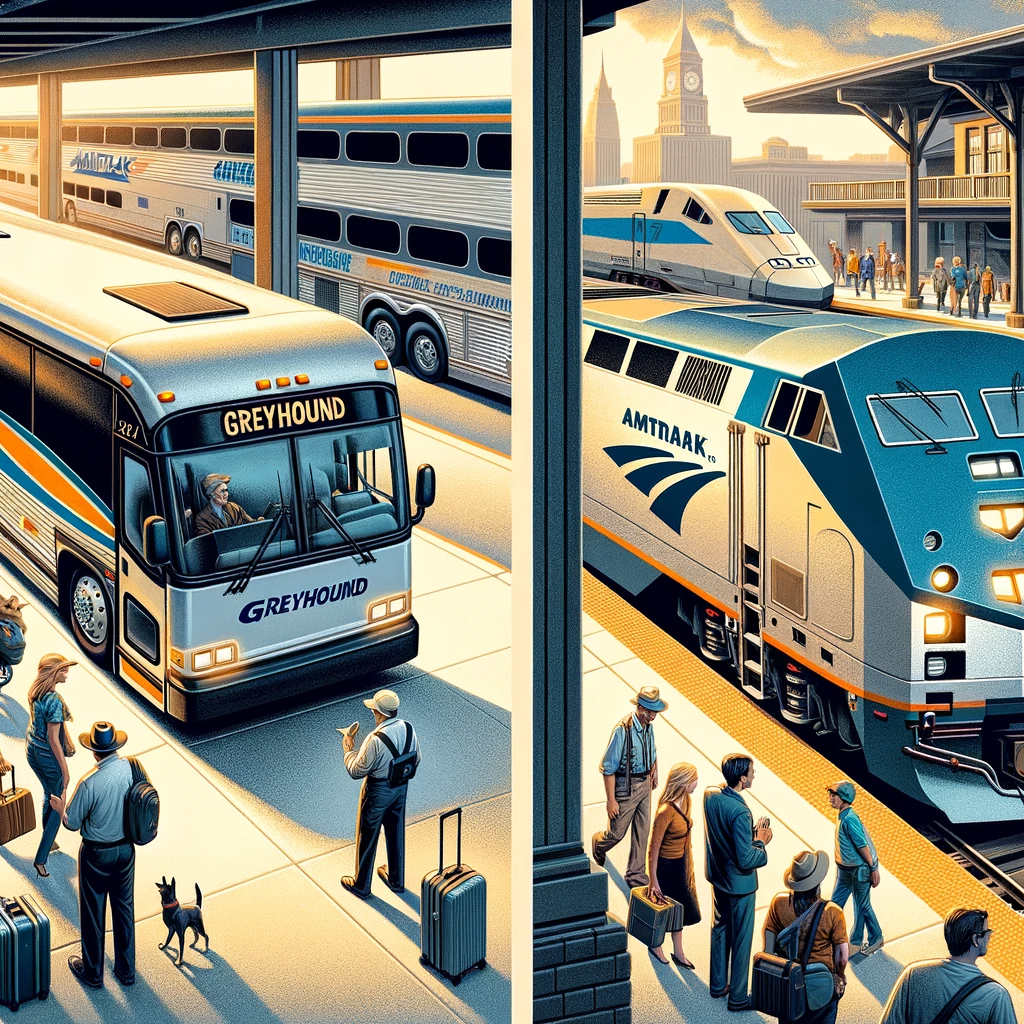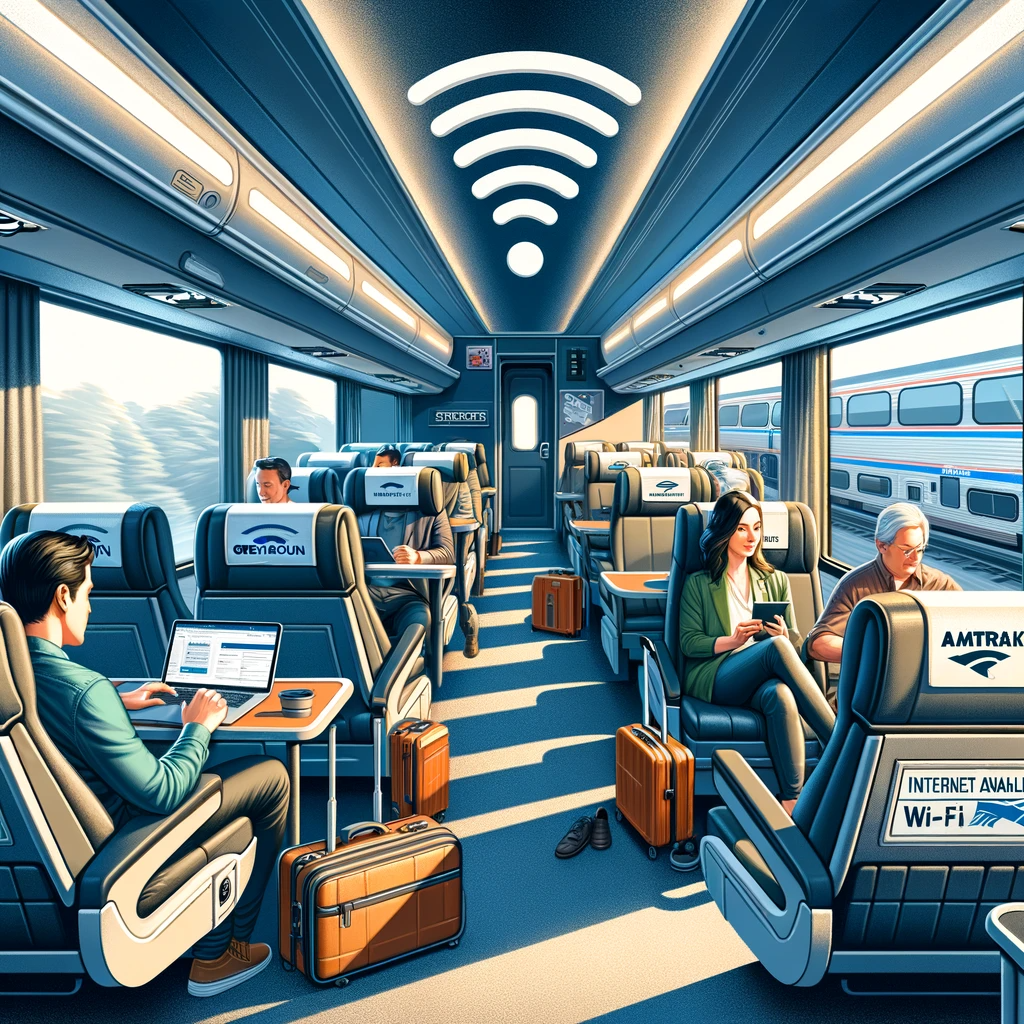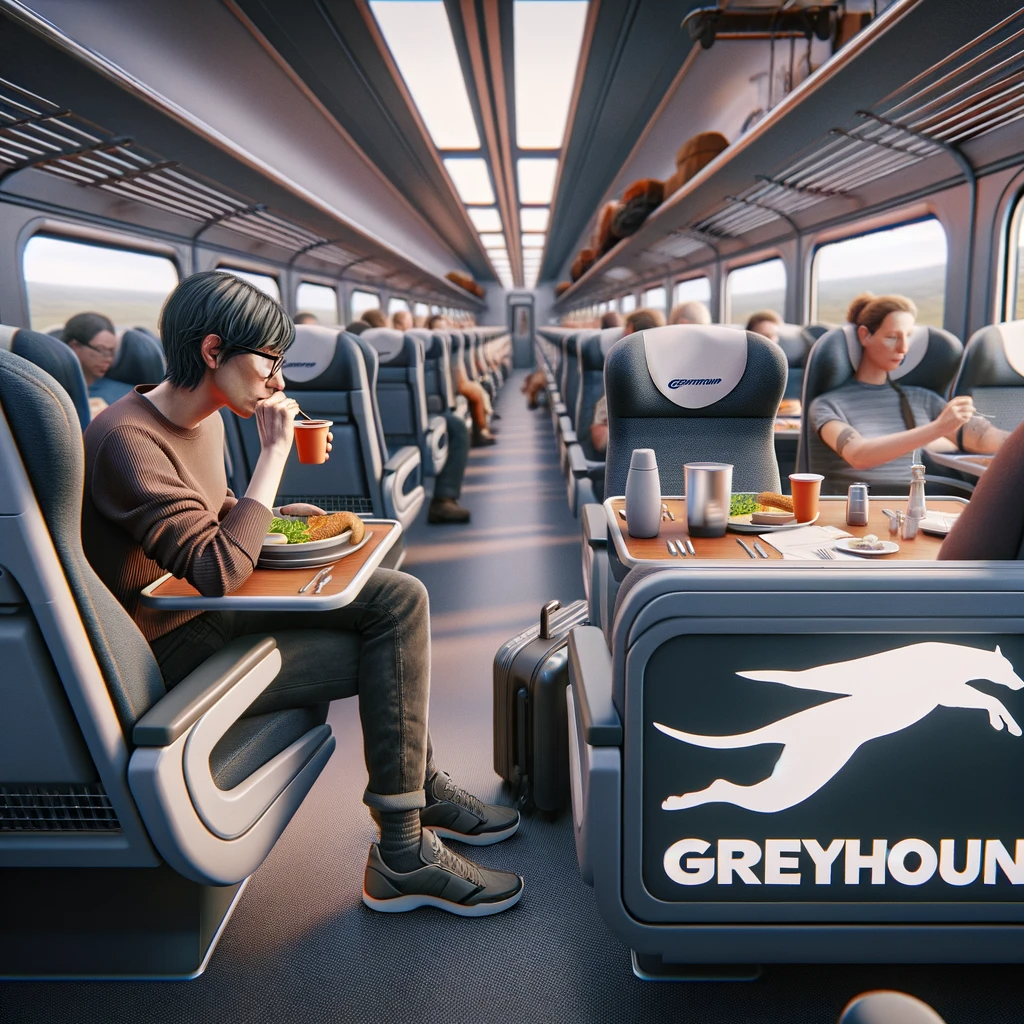Living in Bakersfield, California, my journey through the vast expanses of the United States has been rich with experiences aboard both Greyhound and Amtrak buses. These adventures have given me a deep appreciation of the contrasting yet equally fascinating worlds of these transportation titans.

In this eye-opening guide, I’ll share an in-depth comparison of Greyhound and Amtrak, drawing from my numerous journeys and a keen understanding of their offerings, as well as insights from their top competitors.
Greyhound: The Road’s Time-Honored Voyager Greyhound, a legendary name in long-distance bus travel, has been mastering the art of road connectivity for over a century. This service is not just a bus ride; it’s a journey through the heart of America, linking cities and remote towns with an unparalleled route network.
Amtrak: The Train Expert’s Road Companion Amtrak, with its celebrated reputation in train travel, brings its excellence to the highways with the Thruway Connecting Services. It’s where the efficiency of rail meets the flexibility of road travel, offering an integrated experience that marries the best of both worlds.
difference between Amtrak and Greyhound
| Category | Amtrak | Greyhound |
|---|---|---|
| Network & Coverage | Over 500 destinations in 46 states on 21,000 miles of track. | Extensive network with about 2,700 destinations. |
| Booking & Fares | Integrated train-bus ticketing; prices vary by route. | Budget-friendly with dynamic pricing; more fare types. |
| Onboard Comfort | Comfortable seating with more legroom; quiet atmosphere. | Functional leather seats; varies in space and comfort. |
| Amenities | Well-maintained essentials; Wi-Fi in some classes. | Basic amenities; Wi-Fi often unreliable; charging issues. |
| Timeliness | Faster speeds but can face delays due to shared tracks. | Slower speeds but more consistent due to road independence. |
| Convenience | Seamless road-rail integration; better for city-to-city. | Wider destination reach, especially to smaller towns. |
| Customer Service | Responsive and accessible via multiple channels. | Functional but can vary in responsiveness and efficiency. |
| Overall Experience | More comfortable and integrated; higher quality. | More accessible and budget-friendly; practical. |
To track your bus status you can visit at: Greyhound Bus Tracker
Which is more comfortable, Amtrak or Greyhound?
As an experienced traveler, I have journeyed extensively on both Amtrak and Greyhound buses, I can offer a comparative perspective on the comfort level of each service. It’s important to note that comfort can be subjective and varies based on individual preferences and specific experiences.

However, there are some general aspects that can be considered.
Amtrak Bus Comfort:
Seating: Amtrak buses are known for their comfortable & well-padded seats with ample legroom. The seating arrangement is generally more spacious than what you’d find in standard bus services.
Amenities: You’ll find essential amenities like air conditioning and restrooms on most Amtrak buses, and occasionally Wi-Fi and power outlets.
Ride Quality: Amtrak buses usually provide a smooth ride, as they often serve shorter connections and are therefore less prone to wear and tear.
Quiet Atmosphere: Amtrak buses tend to have a more reserved and tranquil atmosphere, contributing to a more relaxed experience, especially on longer journeys.

Greyhound Bus Comfort:
Seating: Greyhound buses offer practical, leather reclining seats. The seating is arranged two per side, eliminating the need to climb over a middle seat. For an additional fee, Greyhound offers early boarding, allowing you to choose your preferred seat.
Amenities: While Greyhound buses provide Wi-Fi and power outlets, the reliability of these amenities can be hit or miss. It’s not uncommon to find the Wi-Fi slow or non-functional, and charging outlets may be out of service. A backup plan, like an unlimited data plan or a good book, is advisable.
Bathroom Facilities of Greyhound buses feature a single restroom, which may vary in cleanliness and can often become crowded.
Comparing Amtrak and Greyhound
When it comes to Amtrak, the comfort extends beyond just seating. Amtrak trains offer different classes, with leather seating in first and some business classes and comfortable, reclining cloth seats in coach. The absence of middle seats is a common feature in both Amtrak and Greyhound.
However, Amtrak differs significantly in that you can opt for a Superliner or Viewliner sleeper car, offering comforts akin to a hotel room.
Wi-Fi on Amtrak trains is generally more reliable than Greyhound, though it depends on the route and proximity to cell towers. Like Greyhound, streaming may not be possible, so having your own data plan is beneficial.
See also: FLIXBUS VS. GREYHOUND – WHICH IS BETTER?
What is the cost difference between Amtrak and Greyhound?
Generally, Amtrak’s travel costs are higher than Greyhound’s, often 30% to 100% more. For example, a one-way Amtrak ticket from Atlanta, GA to New Orleans, LA costs $81.00. The same journey on Greyhound costs just $48.00.
This notable price difference is partly due to the distinct nature of the services each company offers. Amtrak, known for its comfortable and comprehensive train services, often commands a higher fare, reflective of the different travel experiences it provides. On the other hand, Greyhound, focusing on budget-friendly and extensive bus services, offers more economical options suited to cost-conscious travelers.
The cost difference between Amtrak and Greyhound can vary significantly depending on several factors such as the specific route, booking time, travel time, and any promotions or discounts available. Here’s a general overview based on my experiences and understanding of these services:
Amtrak Cost Factors:
- Route Dependency: Amtrak prices can vary greatly depending on the route and distance. Longer, more scenic routes tend to be pricier.
- Booking Time: Similar to airlines, booking an Amtrak ticket well in advance can lead to lower prices. Last-minute tickets are usually more expensive.
- Class of Service: Amtrak offers different classes of service, including Coach, Business, and First-Class, each with varying prices.
- Connections with Train Services: If the bus journey is part of a combined train and bus ticket, the cost might be higher but offers the convenience of integrated travel.
- Discounts and Deals: Discounts for seniors, military personnel, students, and children are available.
Greyhound Cost Factors:
- Budget-Friendly: Greyhound is generally known for its budget-friendly options. These buses are especially for direct, short to medium-distance routes.
- Dynamic Pricing Strategy: Booking in advance can often secure lower prices. Prices can increase closer to the departure date or during high-demand periods.
- Fare Types: Greyhound offers various fare types including Economy, Economy Extra, and Flexible, each with different price points and levels of flexibility.
- Promotions: Greyhound frequently runs promotions and discounts, which can significantly reduce travel costs.
Which is safer Amtrak or Greyhound?
When discussing the safety of Amtrak versus Greyhound, it’s important to consider various aspects of safety, including the physical condition of vehicles, the training and reliability of the staff, and the overall safety record of each service. Both Amtrak and Greyhound have established protocols and measures to ensure passenger safety, yet each has its own strengths and challenges.
Safety on Amtrak Buses:
Regulatory Oversight: Amtrak, primarily known for its train services, extends the same high safety standards to its bus services. The Federal Railroad Administration (FRA), along with state transportation departments, regulates Amtrak’s operations, including its buses.
Driver Training and Standards: Amtrak’s drivers are typically well-trained, adhering to rigorous safety protocols. Given that their bus services often connect to train routes, there’s an emphasis on maintaining a high safety standard to complement their overall service.
Vehicle Maintenance and Safety Checks: Amtrak buses are regularly maintained and inspected. The integration of bus services with their trains means they are likely to follow stringent maintenance schedules similar to their rail counterparts.
Safety Features: Amtrak buses are equipped with standard safety features like seat belts & emergency exits
Safety on Greyhound Buses:
Experience and Scale: Greyhound, with its vast network and long history in bus transportation, has a wealth of experience in ensuring passenger safety. The sheer scale of their operations means they have extensive protocols in place.
Driver Training: Greyhound drivers undergo thorough training, including safe driving practices and emergency response. They are required to meet specific standards and hold commercial driver’s licenses.

Bus Maintenance: Regular maintenance and safety checks are part of Greyhound’s operational procedures. Their buses are equipped with necessary safety features and are inspected regularly to ensure they meet safety standards.
Safety Initiatives: Greyhound has implemented several safety initiatives over the years, including the installation of GPS tracking and real-time monitoring systems to enhance safety and security.
Which is more timely, Amtrak or Greyhound?
Determining which service is more timely between Amtrak and Greyhound involves considering various factors, including speed, routes, and potential delays.
Amtrak Timeliness:
- Speed: Amtrak’s trains can reach speeds between 110 to 145 miles per hour. However, the actual travel time may vary based on the specific route and number of stops.
- Delays: While trains generally don’t face traffic delays like buses, Amtrak shares tracks with freight trains, which can cause delays. Amtrak’s on-time arrivals have been decreasing in recent years, with notable delays in some states.
- Weather Resistance:Trains handle bad weather better than buses. However, extreme conditions like downed trees or damaged power lines can still disrupt them.
Greyhound Timeliness:
- Speed: Greyhound buses travel at about 70 miles per hour. The total travel time can be influenced by the route and number of stops.
- Delays: Being road-based, Greyhound buses are susceptible to traffic conditions, construction, accidents, and weather-related delays like snowstorms or heavy rainfall.
- Consistency: Greyhound could be more consistent, as its buses are less affected by infrastructure sharing issues that often impact Amtrak.
Comparative Examples
- Ann Arbor, MI to Pittsburgh, PA: A trip by car takes about 4.5 hours. By Amtrak, it ranges from 9 to 19 hours, while a Greyhound bus takes about 9 hours.
- Portland, OR to Seattle, WA: By car, the journey takes about 2.5 hours. Amtrak takes around 3.5 hours, and Greyhound ranges from 3 to 3.5 hours.
See Also: How much is bus ticket from Alabama to Michigan?
Which is more convenient, Amtrak or Greyhound?
When comparing the convenience of Greyhound and Amtrak, Greyhound generally has an advantage due to its expansive reach. With America boasting around 4 million miles of roadways, Greyhound leverages this extensive network to offer routes to about 2,700 destinations.
This wide coverage makes Greyhound particularly convenient for travelers heading to smaller towns or specific locations like a relative’s house or a wedding venue, as it often provides direct access to these less urbanized areas.
On the other hand, Amtrak, while operating on over 21,000 miles of track, serves over 500 destinations in 46 states. While this is impressive, it primarily caters to larger cities with established train stations.
Therefore, if your final destination is a smaller town not directly on an Amtrak route, you might need to arrange additional transportation from the nearest Amtrak station to your final destination.
In summary, Greyhound’s extensive route network across a vast number of destinations offers greater convenience for reaching more varied and specific locations, particularly in areas not served by rail.
Amtrak and Greyhound Customer Services
When assessing the Customer Service Quality of Amtrak and Greyhound, it’s important to consider several factors, including the availability, responsiveness, and helpfulness of their customer service teams, as well as the overall customer experience.
Amtrak Customer Service:
Accessibility: Amtrak offers multiple channels for customer service, including phone support, email, and in-person assistance at stations. Their website also provides a comprehensive FAQ section and a live chat feature for immediate assistance.
Responsiveness: Amtrak is generally known for its responsive customer service. Passengers can expect timely responses to their queries, both over the phone and through digital platforms.
In-Station Service: At train stations, Amtrak typically has staff available to assist with inquiries, ticketing, and any travel-related issues. This in-person support can be particularly valuable for immediate assistance and for passengers with special needs.
Overall Experience: Amtrak’s customer service is often praised. It stands out for providing detailed travel information and handling reservations efficiently.
Their commitment to customer satisfaction is evident in their continuous efforts to improve service quality.
Greyhound Customer Service:
Accessibility: Greyhound also offers various customer service channels, including a national toll-free number, email support, and in-person assistance at Greyhound stations.
Responsiveness: The responsiveness of Greyhound’s customer service can vary. While there are instances of prompt and helpful service, some passengers have reported delays or difficulties in getting timely assistance, particularly during peak travel times or for complex issues.
Station Support: At Greyhound stations, the level of service can vary depending on the location and staff availability. In major stations, customer service is generally more accessible and helpful.
Overall Experience: Greyhound’s customer service is functional and covers the basic needs of travelers. However, the experience may not be as consistent or comprehensive as Amtrak’s, particularly in terms of personalized attention and swift problem resolution.
FREQUENTLY ASKED QUESTIONS
Which service offers more comfortable seating?
- Amtrak generally offers more spacious and comfortable seating. Their buses are equipped with well-padded seats, providing ample legroom, which is particularly beneficial for longer journeys. The design is focused on comfort, aligning with Amtrak’s overall standard in passenger services.
- Greyhound, while offering functional seating arrangements, might not match the spaciousness and comfort level of Amtrak. Greyhound buses feature standard leather seats that are designed more for practicality and durability than luxury. The seating may be adequate for shorter trips but could be less comfortable for longer journeys.
Amenities of Amtrak or Greyhound
Amtrak buses are known for well-maintained amenities. These typically include air conditioning, restrooms, and sometimes Wi-Fi and power outlets. The overall maintenance and quality of these amenities tend to be higher, ensuring a more comfortable experience. Greyhound also provides essential amenities like Wi-Fi and power outlets, but their reliability and quality can vary. It’s not uncommon for passengers to experience issues with Wi-Fi connectivity or power outlets not working, which can impact the comfort level, especially on longer trips.
Which service is more reliable for on-time arrivals?
Amtrak can experience delays due to shared tracks with freight trains, but generally maintains good reliability.
Greyhound’s reliability depends on road traffic and weather. However, they generally maintain consistency in road-based transport.
Which service has a better safety record?
Amtrak and Greyhound both follow strict safety regulations. Amtrak benefits from regulated rail travel safety, while Greyhound concentrates on road safety protocols.
Which is generally more comfortable?
- Amtrak is often seen as more comfortable due to its spacious seating and quieter atmosphere.
- Greyhound provides basic comfort suitable for shorter trips, though it might be less ideal for longer journeys.
Which is more cost-effective?
- Greyhound is typically more budget-friendly, offering economical fares and various discounts.
- Amtrak is generally more expensive, reflecting its higher level of service and amenities.
Which service is faster?
- Amtrak’s trains have higher top speeds, potentially making them faster, but actual travel times can vary based on the route.
- Greyhound buses, while slower, may offer more direct routes to certain destinations.
Which service is more popular among travelers?
- Amtrak is popular for its comfortable and scenic train journeys, especially among those who prefer train travel.
- Greyhound is popular for its vast network, affordability, and access to numerous destinations.
- How Much is a Greyhound Bus Ticket from Pretoria to Durban? - January 25, 2024
- Does Greyhound Check for Warrants? - January 25, 2024
- Amtrak Vs. Greyhound – Which is Better? - December 12, 2023